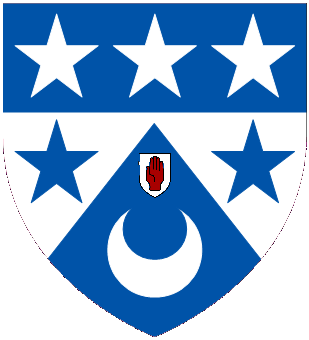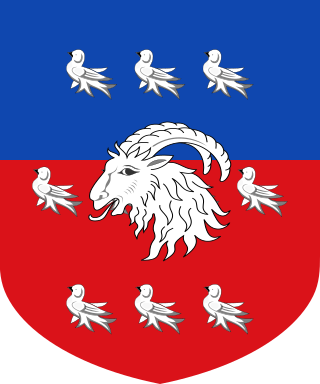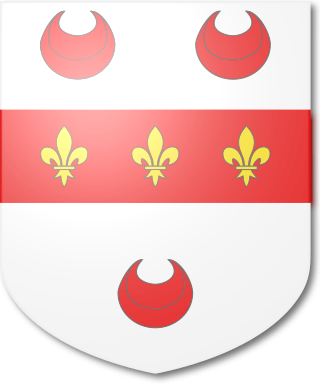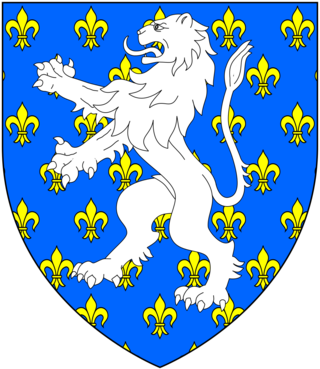
Viscount Hardinge, of Lahore and of Kings Newton in the County of Derby, is a title in the Peerage of the United Kingdom. It was created in 1846 for the soldier and Tory politician Sir Henry Hardinge. His son, the second Viscount, represented Downpatrick in Parliament. His great-great-grandson, the sixth Viscount, succeeded a distant relative as eighth Baronet, of Belle Isle in the County of Fermanagh, in 1986. This title had been created in the Baronetage of the United Kingdom 1801 for Richard Hardinge. He was the third son of Nicolas Hardinge, younger brother of Reverend Henry Hardinge and uncle of the latter's third son Henry Hardinge, 1st Viscount Hardinge. The baronetcy was created with special remainder to the heirs male of Richard Hardinge's father.

Baron Avebury, of Avebury in the County of Wiltshire, is a title in the Peerage of the United Kingdom. It was created 22 January 1900 for the banker, politician and archaeologist Sir John Lubbock, 4th Baronet. He was succeeded by his eldest son, the second Baron. On his death the titles passed to his nephew, the third Baron. He was the son of Harold Fox Pitt Lubbock, fourth son of the first Baron, who died in 1971. The title then passed to the third Baron's first cousin, the fourth Baron, the son of Maurice Fox Pitt Lubbock, sixth son of the first Baron. The fourth baron was a Liberal Democrat politician and one of the ninety excepted hereditary peers who remained in the House of Lords after the passing of the House of Lords Act 1999. He was succeeded by his son, the fifth Baron, in 2016.
Lieutenant Colonel Sir John Reginald Noble Graham, 3rd Baronet, was a British businessman, army officer and a recipient of the Victoria Cross, the highest award for gallantry in the face of the enemy that can be awarded to British and Commonwealth forces. He received the award "for most conspicuous bravery, coolness and resource when in command of a Machine Gun Section" during the Samarra offensive in 1917, during the First World War.

The Arnott Baronetcy, of Woodlands in the Parish of St Anne, Shandon in the County of Cork, is a title in the Baronetage of the United Kingdom. It was created on 12 February 1896 for the Irish entrepreneur and philanthropist John Arnott.
There have been two baronetcies created for persons with the surname Aykroyd, both in the Baronetage of the United Kingdom for members of the same family.

The Wigram Baronetcy, of Walthamstow House in the County of Essex, is a title in the Baronetage of the United Kingdom. It was created on 30 October 1805 for Robert Wigram, a successful shipbuilding merchant and politician, representing Fowey and Wexford Borough in the House of Commons. The second Baronet also represented Wexford Borough in Parliament. He assumed in 1832 by Royal licence the surname of Fitzwygram. The fourth Baronet was a Lieutenant-General in the army and sat as a Conservative Member of Parliament for South Hampshire and Fareham.

The Boord Baronetcy, of Wakehurst Place in the County of Sussex, is a title in the Baronetage of the United Kingdom. It was created on 18 February 1896 for the Conservative politician Thomas Boord. His eldest son, the second Baronet, died unmarried in 1928 and was succeeded by his nephew, the third Baronet. He was the son of Alexander Edgar Boord, third son of the first Baronet. The third Baronet's eldest son, the fourth Baronet, succeeded in 1975. On his death in 2019, the title passed to his nephew Andrew, an Istanbul-based translator and business development consultant.

The Hammick Baronetcy, of Cavendish Square, London, is a title in the Baronetage of the United Kingdom. It was created on 25 July 1834 for the noted surgeon and physician Stephen Hammick.

The Oakeley Baronetcy, of Shrewsbury, is a title in the Baronetage of Great Britain. It was created on 5 June 1790 for the Indian administrator Charles Oakeley. He served as Governor of Madras from 1790 to 1794. Frederick Oakeley was the second son of the first Baronet.

The Currie Baronetcy is a title in the Baronetage of the United Kingdom. It was created on 11 January 1847 for Frederick Currie, Foreign Secretary to the Indian Government and a member of the Supreme Council of India. He was a grandson of William Currie (1721–1781), nephew of William Currie (1756–1829), who was Member of Parliament for Upper Gatton and Winchelsea, and the brother of Vice-Admiral Mark John Currie.

The Muir Mackenzie Baronetcy, of Delvine in the County of Perth, is a title in the Baronetage of the United Kingdom. It was created on 9 November 1805 for Alexander Muir Mackenzie. Born Alexander Muir, he had assumed the additional surname of Mackenzie on succeeding to the estates of his great-uncle John Mackenzie, of Delvine, Perthshire, third son of Sir Kenneth Mackenzie, 1st Baronet, of Coul.

The Pechell, later Brooke-Pechell, later Pechell Baronetcy, of Paglesham in the County of Essex, was a title in the Baronetage of Great Britain.
There have been three baronetcies created for personswith the surname Elphinstone, two in the Baronetage of Nova Scotia and one in the Baronetage of the United Kingdom. As of 2008 two of the creations are extant while one is dormant.

The Hudson, later Palmer Baronetcy, of Wanlip Hall in the County of Leicester, was created in the Baronetage of Great Britain on 28 July 1791 for Charles Grave Hudson, a Director of the South Sea Company and High Sheriff of Leicestershire in 1784. In 1813 the second Baronet assumed by royal sign-manual the surname of Palmer in lieu of his patronymic on succeeding to the estates of his maternal grandfather, Henry Palmer, of Wanlip. The title vests in its ninth holder.

The Pole, later de-la-Pole, later Reeve-de-la-Pole Baronetcy, of Shute House in the County of Devon, was created in the Baronetage of England on 12 September 1628 for John Pole, Member of Parliament for Devon. It was created during the lifetime of his father, the historian of Devon, Sir William Pole (d.1635), Knight, MP, of Colcombe Castle and Shute in Devon. The second Baronet was Member of Parliament for Honiton. The third Baronet represented Lyme Regis, Bossiney, Devon, East Looe and Newport in the House of Commons. The fourth Baronet was Member of Parliament for Newport, Camelford, Devon, Bossiney and Honiton. The sixth Baronet represented West Looe in Parliament. In 1790 he assumed the surname of de-la-Pole, which his successor discontinued. The eighth Baronet assumed in 1838 the surname of Reeve-de-la-Pole but later discontinued it.
The Curtis baronetcy, of Cullands Grove, Southgate in the County of Middlesex, was created in the Baronetage of the United Kingdom on 23 December 1802 for Sir William Curtis, 1st Baronet, the son of a wealthy London biscuit manufacturer. He was member of parliament for the City of London from 1790 to 1818 and 1820 to 1826 and Lord Mayor of London from 1794 to 1795. He was later offered a peerage but declined. The third Baronet moved the family seat to Caynham Court, Caynham, Shropshire in 1852 and was High Sheriff of Shropshire in 1857. The fourth and fifth Baronets were both succeeded by cousins. The Shropshire estate was sold following the death of the sixth Baronet. The family seat is now at Bishops Waltham, Hampshire
The Maxwell baronetcy of Monreith was created in the Baronetage of Nova Scotia on 8 January 1681 for William Maxwell of Monreith House in Mochrum, Wigtownshire.

The Doyle baronetcy, of Buscombe, was created 18 February 1828 in the Baronetage of the United Kingdom for Lieutenant Colonel Francis Doyle. It became extinct in 1987.

The Graham baronetcy, of Norton Conyers in the County of York, was created in the Baronetage of England on 17 November 1662, for Richard Graham. He was the second son of the first of the Graham baronets of Esk (1629): the title was in honour of his late father's services to the Royalist cause, recognised after The Restoration of the monarchy.

The Graham Baronetcy, of Netherby in the County of Cumberland, was created in the Baronetage of Great Britain on 15 January 1783 for James Graham. He later represented Ripon in the House of Commons. This branch of the Graham family was connected with William Grahme, fourth son of the 2nd Baronet of the Graham baronets of Esk (1629). James Graham was son of Robert Grahme D.D., son of William Grahme.















